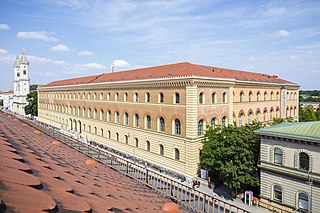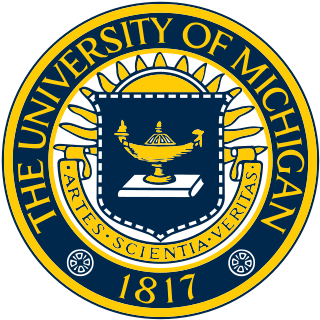Related Research Articles

The Internet Archive is an American non-profit organization founded in 1996 by Brewster Kahle that runs a digital library website, archive.org. It provides free access to collections of digitized media including websites, software applications, music, audiovisual, and print materials. The Archive also advocates a free and open Internet. Its mission is committing to provide "universal access to all knowledge".
The Million Book Project was a book digitization project led by Carnegie Mellon University School of Computer Science and University Libraries from 2007 to 2008. Working with government and research partners in India and China, the project scanned books in many languages, using OCR to enable full text searching, and providing free-to-read access to the books on the web. As of 2007, they have completed the scanning of 1 million books and have made the entire catalog accessible online.

Digitization is the process of converting information into a digital format. The result is the representation of an object, image, sound, document, or signal obtained by generating a series of numbers that describe a discrete set of points or samples. The result is called digital representation or, more specifically, a digital image, for the object, and digital form, for the signal. In modern practice, the digitized data is in the form of binary numbers, which facilitates processing by digital computers and other operations, but digitizing simply means "the conversion of analog source material into a numerical format"; the decimal or any other number system can be used instead.

The Vatican Apostolic Library, more commonly known as the Vatican Library or informally as the Vat, is the library of the Holy See, located in Vatican City, and is the city-state's national library. It was formally established in 1475, although it is much older—it is one of the oldest libraries in the world and contains one of the most significant collections of historical texts. It has 75,000 codices from throughout history, as well as 1.1 million printed books, which include some 8,500 incunabula.

The Bavarian State Library in Munich is the central "Landesbibliothek", i. e. the state library of the Free State of Bavaria, the biggest universal and research library in Germany and one of Europe's most important universal libraries. With its collections currently comprising around 10.89 million books, it ranks among the leading research libraries worldwide. The Bayerische Staatsbibliothek furthermore is Europe's second-largest journals library. Furthermore, its historical holdings encompass one of the most important manuscript collections of the world, the largest collection of incunabula worldwide, as well as numerous further important special collections. Its collection of historical prints before 1850 totals almost one million units.

The University of Michigan Library is the academic library system of the University of Michigan. The university's 38 constituent and affiliated libraries together make it the second largest research library by number of volumes in the United States.

Google Books is a service from Google that searches the full text of books and magazines that Google has scanned, converted to text using optical character recognition (OCR), and stored in its digital database. Books are provided either by publishers and authors through the Google Books Partner Program, or by Google's library partners through the Library Project. Additionally, Google has partnered with a number of magazine publishers to digitize their archives.

The University of California, Santa Barbara Library is the university library system of the University of California, Santa Barbara in Santa Barbara, California. The library has some three million print volumes, 30,000 electronic journals, 34,450 e-books, 900,055 digitized items, five million cartographic items, more than 3.7 million pieces of microform, 167,500 sound recordings, and 4,100 manuscripts. The library states that it holds 3.2 miles (5.1 km) of manuscript and archival collections.

The National Library of Israel, formerly Jewish National and University Library, is the library dedicated to collecting the cultural treasures of Israel and of Jewish heritage. The library holds more than 5 million books, and is located in the Government complex near the Knesset.

The Getty Research Institute (GRI), located at the Getty Center in Los Angeles, California, is "dedicated to furthering knowledge and advancing understanding of the visual arts".
The Michigan Digitization Project is a project in partnership with Google Books to digitize the entire print collection of the University of Michigan Library. The digitized collection is available through the University of Michigan Library catalog, Mirlyn, the HathiTrust Digital Library, and Google Books. Full-text of works that are out of copyright or in the public domain are available.

Palm-leaf manuscripts are manuscripts made out of dried palm leaves. Palm leaves were used as writing materials in the Indian subcontinent and in Southeast Asia dating back to the 5th century BCE. Their use began in South Asia and spread to other regions, as texts on dried and smoke-treated palm leaves of the Palmyra or talipot palm. Their use continued until the 19th century when printing presses replaced hand-written manuscripts.

The Library of Catalonia is the Catalan national library, located in Barcelona, Catalonia, Spain. The primary mission of the Library of Catalonia is to collect, preserve, and spread Catalan bibliographic production and that related to the Catalan linguistic area, to look after its conservation, and to spread its bibliographic heritage while maintaining the status of a center for research and consultation.

The National Library of the Czech Republic is the central library of the Czech Republic. It is directed by the Ministry of Culture. The library's main building is located in the historical Clementinum building in the centre of Prague, where approximately half of its books are kept. The other half of the collection is stored in the district of Hostivař. The National Library is the biggest library in the Czech Republic, housing around 6 million documents. The library currently has 20 627 registered readers. Although comprising mostly Czech texts, the library also stores older material from Turkey, Iran and India. The library also houses books for Charles University in Prague.

Duke University Libraries is the library system of Duke University, serving the university's students and faculty. The Libraries collectively hold some 6 million volumes.

The State Central Library Hyderabad, known as the State Central Library (SCL) earlier known as Kutub Khana Asafia, is a public library in Hyderabad, Telangana. The library was first established in 1891 at a location in Abids where the General Post Office is today situated. The library was shifted to its present location in 1936 and today is one of the most imposing structures in the city. The building housing the library was granted heritage status in 1998 by INTACH, Hyderabad.

The Prime Ministers' Museum and Library Society previously known as the Nehru Museum and Library Society is a museum and library in New Delhi, India, which aims to preserve and reconstruct the history of the Indian independence movement. Housed within the Teen Murti House complex, it is an autonomous institution under the Indian Ministry of Culture, and was founded in 1964 after the death of India's first prime minister, Jawaharlal Nehru. It aims to foster academic research on modern and contemporary history. Today, the Nehru Memorial Library is the world's leading resource centre on India's first prime minister. Its archives contain the bulk of Mahatma Gandhi's writings, as well as private papers of Swami Sahajanand Saraswati, C. Rajagopalachari, B. C. Roy, Jayaprakash Narayan, Charan Singh, Sarojini Naidu and Rajkumari Amrit Kaur. In March 2010, it launched a digitization project of its archives, and by June 2011, 867,000 pages of manuscripts and 29,807 photographs had been scanned and 500,000 pages had been uploaded on the digital library website. Amongst noted publications of the NMML are Selected Works of Jawaharlal Nehru, Man of Destiny by Ruskin Bond, and Nehru Anthology (1980).

The Sikh Reference Library was a repository of an estimated 20,000 literary works located in the Darbar Sahib at Amritsar, Punjab which was destroyed during Operation Blue Star. In 1984, the library's contents were confiscated by the Central Bureau of Investigation (CBI) and the empty building allegedly burned to the ground by the Indian Army on 7 June. In recent years the Shiromani Gurdwara Parbandhak Committee (SGPC) has attempted to recover the looted material but has not yet recovered substantial materials. To date, the status of library manuscripts and artifacts is unclear; the vast majority remain in the hands of the government, a few office files and passports were returned, and as many as 117 items were destroyed for being "seditious" materials. After the events of Operation Blue Star, the library was revived and its current collection has surpassed the total contents of the original library.

The Sayaji Rao Gaekwad Library, also known as the Central Library, is the main library of Banaras Hindu University (BHU) in Varanasi, Uttar Pradesh in India. Established in 1917, it is listed in the Survey of Manuscripts in India. The present building of the library was built in 1941 on pattern of British Museum, at the suggestion of Pandit Madan Mohan Malaviya, the founder of university, after his return from the Round Table Conference, London in 1931, with a donation from the Sayajirao Gaekwad III, Maharaja of Baroda State from 1875 to 1939, known for establishing libraries throughout his state.
Srujanika is an Indian nonprofit organisation headquartered in Bhubaneswar, Odisha. It works for research and innovation in science, education and development with a focus on Odia language. It has published a popular science books, and periodicals like Bigyan Tarang since 1988-89 that has 17 volumes and 105 issues. The organization was founded in 1983 by a couple Nikhil Mohan Pattnaik and Puspashree Pattnaik. It scanned a large volume of public domain and other books including 26 Odia dictionaries, all the 105 issues of Bigyan Tarang and other publications of their own. Srujanika collaborated with National Institute of Technology, Rourkela Pragati Utkal Sangha to create an Open Access repository called Open Access to Oriya Books that contains 561 digitally scanned books. On 12 November 2017, Srujanika launched their brand new website odiabibhaba.in containing digitised books, dictionaries, magazine and newspaper archives, reference material, language methods and other information.
References
- "Google to digitise 800,000 books at Mysore varsity," Hindustan Times (Indo-Asian News Service, New Delhi). 20 May 2007.
- Riding, Alan. "France Detects a Cultural Threat in Google," The New York Times. 11 April 2005.